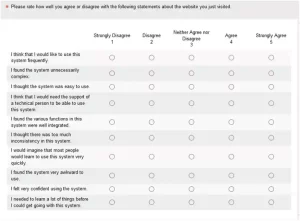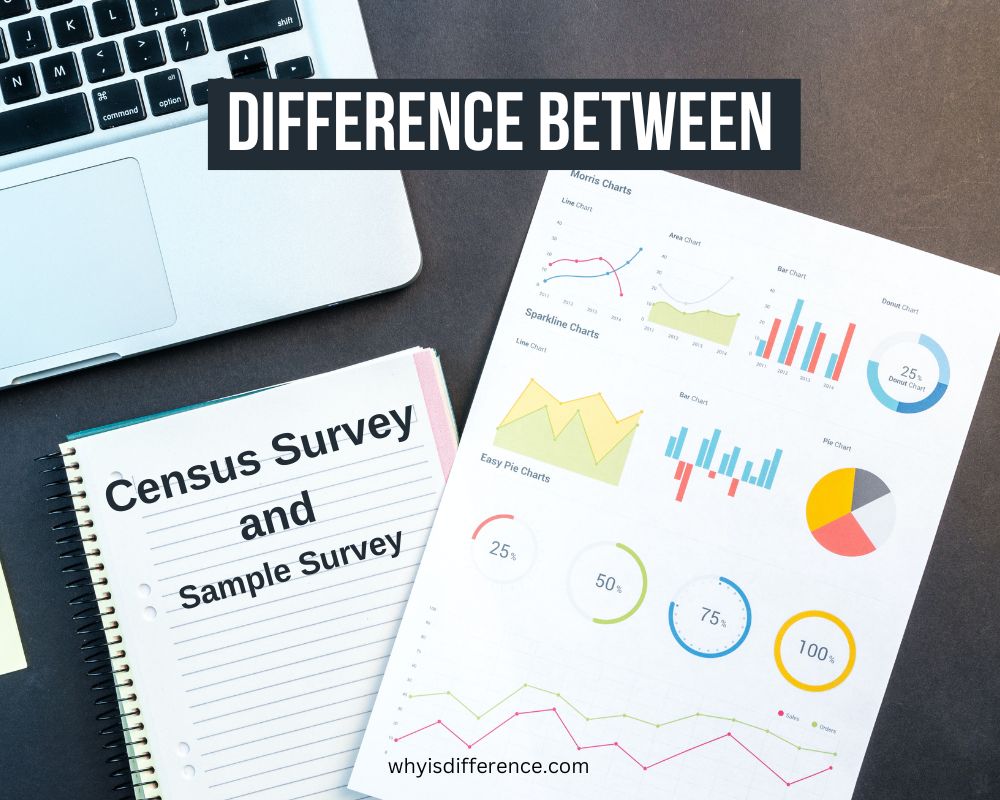Census Survey and Sample Survey: All over the globe, surveys are conducted to gather information about the population to help improve the products and services offered by a business. The sample survey and the census survey are two of many survey techniques.
Although there are similarities in the two techniques, they also have many differences. The type of survey you choose will depend on the time and circumstances available. To clear up any doubts, this article will describe the characteristics of two different types of surveys.
What is the definition of census surveying?

Census Surveys are systematic and thorough approaches to collecting information about every individual or unit within a population, via counting each person or unit and gathering their individual characteristics, demographics, and socioeconomic aspects.
They allow for deeper insights into characteristics like characteristics of gender identity or socioeconomic standing that provide vital data that assists policy planning, resource allocation, and demographic analyses. Census surveys can often be found conducted by government agencies or statistical organizations and can serve as invaluable information sources in policy development as well as demographic analyses.
What are the characteristics of an ideal sample survey?
Sample Surveys are an efficient method for gathering information from subsets or samples of people or groups within an interest population. A sample survey uses random sampling techniques to select this subset; once selected, data derived from it can then be analyzed in order to draw meaningful conclusions about its entirety – making sample surveys ideal in social sciences, opinion polling,

and market research applications as they allow information collection efficiently without breaking the bank.
Importance of population data collection
Data about population is an indispensable element of government planning and policy formulation, helping governments gain insight into demographics, the social makeup, needs, and preferences of its population as well as formulate policies in areas like healthcare delivery, education infrastructure development as well as social welfare provision.
- Resource Allocation Accurate population data allows governments and organizations to allocate resources efficiently and fairly, understanding where these should go such as schools, hospitals, and transportation needs. By understanding population distribution and size distribution it allows governments and organizations to allocate their resources more appropriately than before e.g. schools hospitals transportation etc
- Data about the population can provide insightful knowledge into the economic and social conditions of an entire community, helping identify trends, disparities, and development opportunities that lead to smart decision-making about job creation, economic development, poverty reduction, and living standards.
- Information on population is invaluable when planning infrastructure. By understanding age and geographic distribution as well as density and size data for populations in various locations around the globe, governments are better able to develop infrastructure such as utilities and housing that meets current and future population demands.
- Data about the population is indispensable when planning public health and healthcare services and facilities, helping identify disease patterns, risks and healthcare requirements across different segments. With this knowledge comes an ability to develop preventive measures and interventions as well as allocate resources accordingly.
- Demographic Research and Analysis – Population data serves as the cornerstone of demographic analysis and research. Researchers use it to investigate population dynamics like fertility rates and mortality rates as well as migration patterns and demographic trends, offering invaluable findings useful in academic study as well as informed decisions for many fields of endeavor.
- Monitoring and Evaluating, Collecting population data allows governments and organizations to continue monitoring and evaluating. Monitoring changes in population allows governments and organizations to assess policies, interventions, successes or areas for further improvements and identify areas for advancement or failures in progress.
Population data provides essential insight for informed decision-making, policy formulation, resource allocation, economic and social development, and well-being. By creating an understanding of all the aspects that comprise a population’s makeup, and its needs can be addressed effectively.
Census Survey
Census Survey, also referred to as Survey, is an extensive and systematic method for collecting information on every individual or unit within a population. A census survey is comprised of counting individuals or units within this population before compiling data about all.
Census surveys are regularly administered by government agencies or statistical organizations; usually every decade. A census provides an accurate picture of population characteristics such as characteristics, demographics, and socio-economic factors that help us gain greater insight.
An effective census requires several steps. These are:
- Plan and Prepare: Census authorities will plan and prepare their survey by selecting an eligible population to survey, as well as setting objectives and creating structures, resources and strategies required for an efficient data collection campaign.
- Questionnaire Design: Census surveys use questionnaires to gather data from households or individuals participating. For optimal data capture while remaining easy and clear for answering, designing an efficient questionnaire design is key to effective census surveys.
- Data Collection: Census surveys use different approaches to gather their information. Enumerators generally visit households to administer questionnaires and collect answers before checking the accuracy and completeness of data collected from households.
- After collecting data: they go through an intensive analysis using statistical techniques for further insight into population health.
- Distributing Results: As part of its final step, census results must be distributed to policymakers, researchers and stakeholders for consideration and use. They typically appear as reports, data sets, or statistical summaries and offer an in-depth description of demographic characteristics within populations.
- Census surveys can bring numerous advantages: By creating an accurate snapshot of all populations, census surveys help policymakers make more informed decisions and allocate resources efficiently while planning future developments more accurately. Furthermore, census data plays a vital role in demography research as well as in tracking economic and social trends over time.
An expensive undertaking that demands considerable resources in terms of human, financial and logistical resources; high response rates while minimizing bias against non-responders may prove challenging; data becomes obsolete with population change thus necessitating periodic updating and adjustment to stay relevant.
Census surveys remain essential tools in understanding and managing populations, providing valuable insight into society as a whole and supporting evidence-based decision-making processes.
Sample Survey
Sample surveys are used as an efficient research method, collecting information from subsets or samples within an interest population. A sampling survey involves selecting individuals out of this larger pool.
Conducting a survey sample typically includes:
- Definition of Population, When initiating any survey, it’s essential that its intended audience (population) is clearly identified and relevant to your research goals. To do this effectively and quickly.
- Next, it is necessary to create an accurate sampling plan. In order to provide each person in your population an equal opportunity at being chosen randomly for this research study, various random sampling techniques must be used.
- Once the design of sampling has been defined, an initial sample will be selected using one or more sampling techniques. Random selection of individuals or groups within populations follows predetermined criteria and rules.
- Data Collection, Methods such as interviews, surveys, and observation can all be employed to gather information about samples. Data collection techniques must be planned carefully to ensure accurate collection.
- Data Analysis, Once collected, data is organized, cleaned up, coded, and analyzed using statistical techniques in order to reach conclusions and draw inferences based on sample results.
Sample surveys serve the primary goal of generalizing about larger populations using their results from one sample survey. Researchers can estimate parameters related to population characteristics as well as determine their margin of error or level of confidence with statistical inference techniques.
Sample surveys offer several advantages. They include:
Cost Efficiency, Sample surveys may be more time and resource efficient than full censuses for populations who reside over wide geographical regions or span large territories. As they require fewer resources for conducting the investigation, sample surveys make more economic sense than full censuses when conducted on large populations with widespread locations.
Generalizability – Even though data collected comes from only a subset, its findings can still apply broadly when selected using appropriate random sampling techniques, providing insights into all population elements.
Flexible sample surveys give researchers more options in regard to survey size and scope; researchers may customize it according to research goals, available resources, or desired precision level.
Survey samples may have their own set of limitations, such as:
Possible Sampling Error, Due to differences between a sample and its population, sampling errors may arise when interpreting results; it is, therefore, essential that one takes note of possible margin of error when making interpretation decisions.
Sample surveys often have limited coverage because their data collection relies on only a subset of the entire population, not representing all its diversity or characteristics. Therefore, sample surveys often underrepresent subgroups or individuals altogether.
Statistics Techniques, For data analysis and inference to be accurate and meaningful interpretation requires using specific statistical tools. Researchers must make use of suitable techniques that ensure correct analysis.
Sample surveys, with their inherent limitations, remain an effective means for social science research, marketing research, and opinion polling purposes. Such polls offer useful insight into population populations while taking into consideration time constraints, resource restrictions and practicality issues.
Comparison between Census Survey and Sample Survey
There are various differences between Sample Surveys and Census Surveys, both from an organizational viewpoint as well as for respondents themselves.
Coverage:
- Census Surveys are undertaken with the intention of surveying every member of society residing on earth; in other words, all individuals or units comprised within it must be included.
- Sample Surveys, Sample surveys gather information on a random subsample of an entire population. While not representing every aspect, such samples provide vital statistics that provide us with more complete and representative pictures.
Precision:
- Precision in Census Survey A census survey strives for both accuracy and precision as its goal is to gather information about all individuals in society.
- Sample Surveys, Sample surveys provide estimates with an acceptable margin of error because data are collected from only a subset of the entire population and then generalized as a generalization for generalized results, though inherent variation and sampling errors could exist in results.
Cost and time considerations:
- A census survey can be an expensive endeavor that demands time, money, and manpower investments in order to effectively cover every population segment and gather accurate information about them. In order to collect all this data and ensure its integrity requires a significant commitment of resources from everyone involved.
- Sample Surveys, Sample surveys can be more time and resource efficient than census surveys due to only collecting information from a subset of people, thus needing less resources for collection.
Data Quality:
- Census Surveys offer thorough, in-depth information about populations. As such, their data quality can be considered highly accurate and trustworthy.
- Sample Surveys, Sample surveys can deliver generalizable results; however, their accuracy and reliability depend on the selection and representativeness of samples used, which could result in bias or variation at random within their cohorts.
Uses and Applications:
- Census Survey Data, Census survey data are essential in policy planning, resource allocation and demographic analyses as they allow us to gain an in-depth view of all characteristics within an entire population. With these insights in hand, decisions are being made with confidence across many areas.
- Sample Surveys can be utilized for monitoring trends, conducting opinion polls, researching markets and creating targeted studies. They allow insight into specific segments of society as well as more targeted analysis.
Census surveys provide a thorough and accurate portrait of a country’s population; however, their costs and resource needs can be significant. Sample surveys tend to be faster and cheaper while still creating variability within sample population size; which method you choose ultimately depends upon research goals, available resources, and the required level of analysis; in practice however census and sample surveys both work well together; the latter providing more frequent updates, insight and extra info that compliment census findings.
Conclusion
Sample surveys and census surveys are vital instruments for gathering information and understanding the population. While census surveys give an exhaustive overview of the populace, samples offer an overview of the entire population, but at a fraction of expense and time. The decision to choose between the two is based on the research goals as well as the resources available and the level of precision you want. In the end, both methods are essential in forming policies, analyzing the social landscape, and expanding our understanding of the world that surrounds us.

